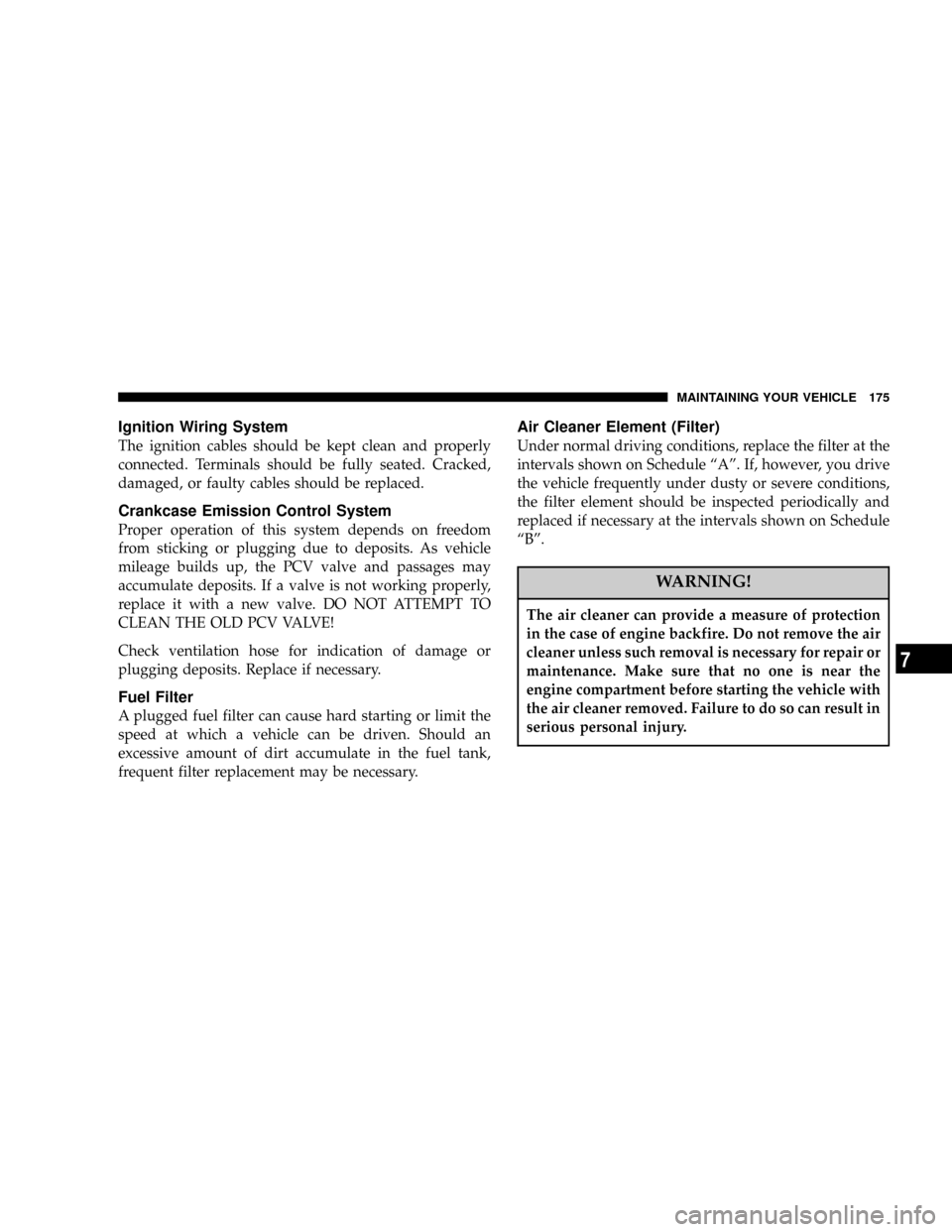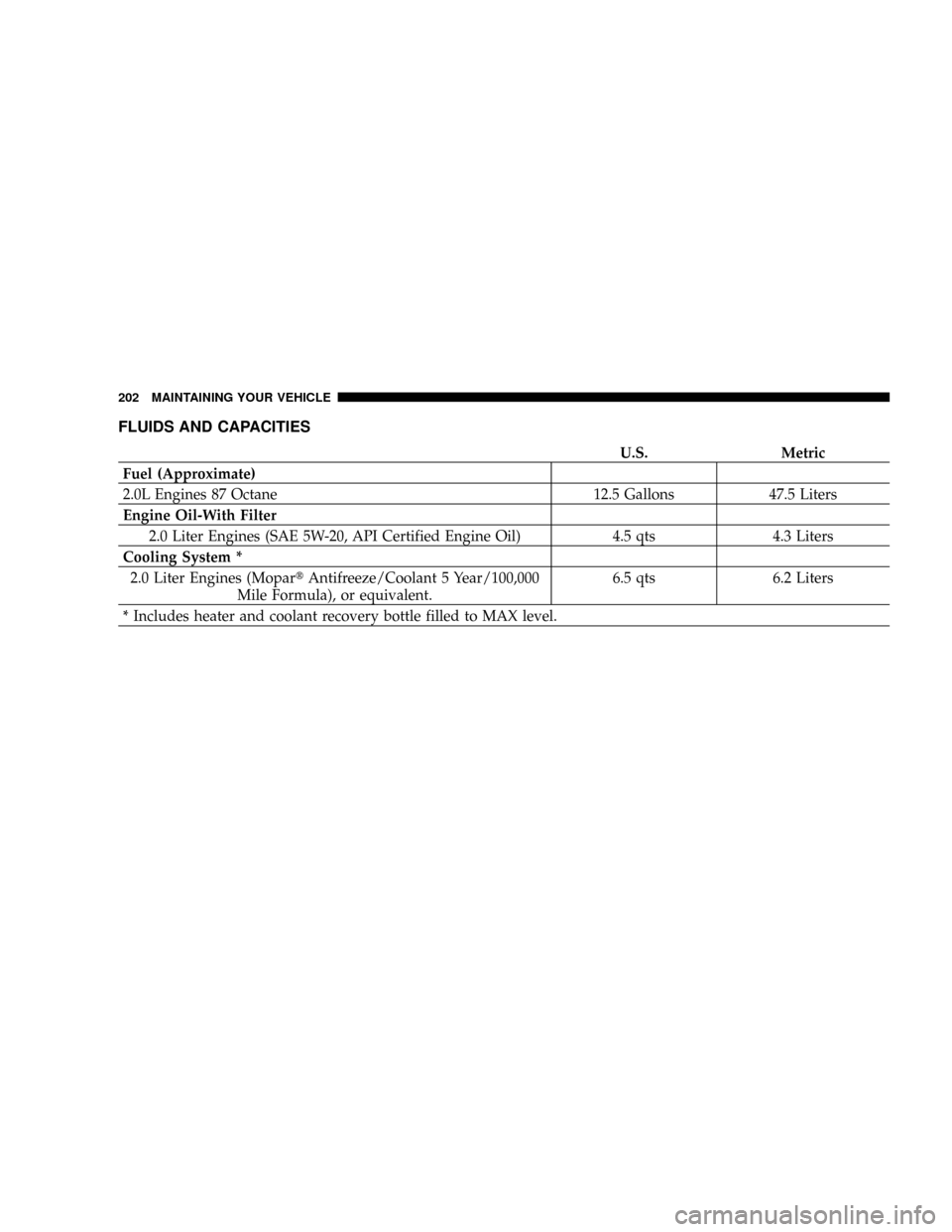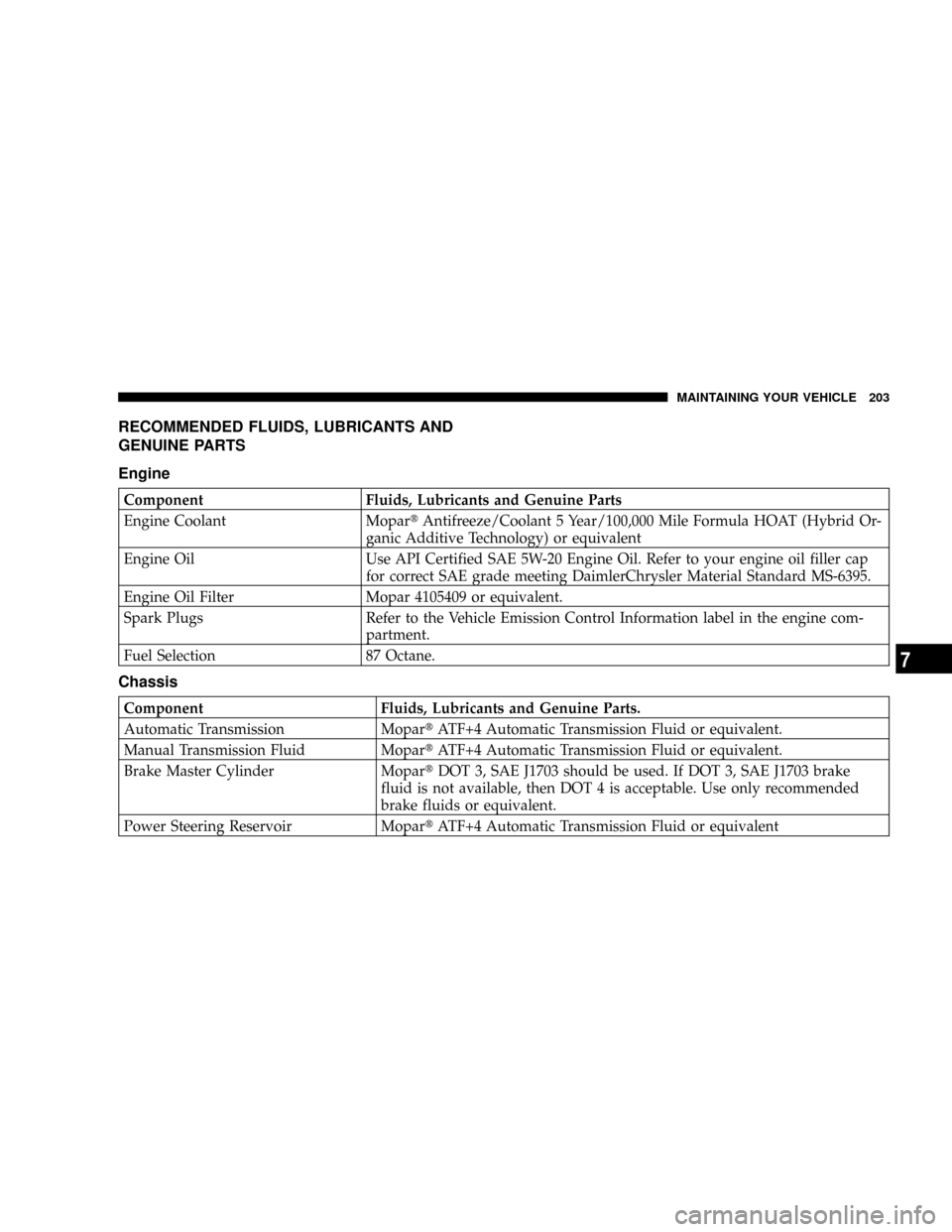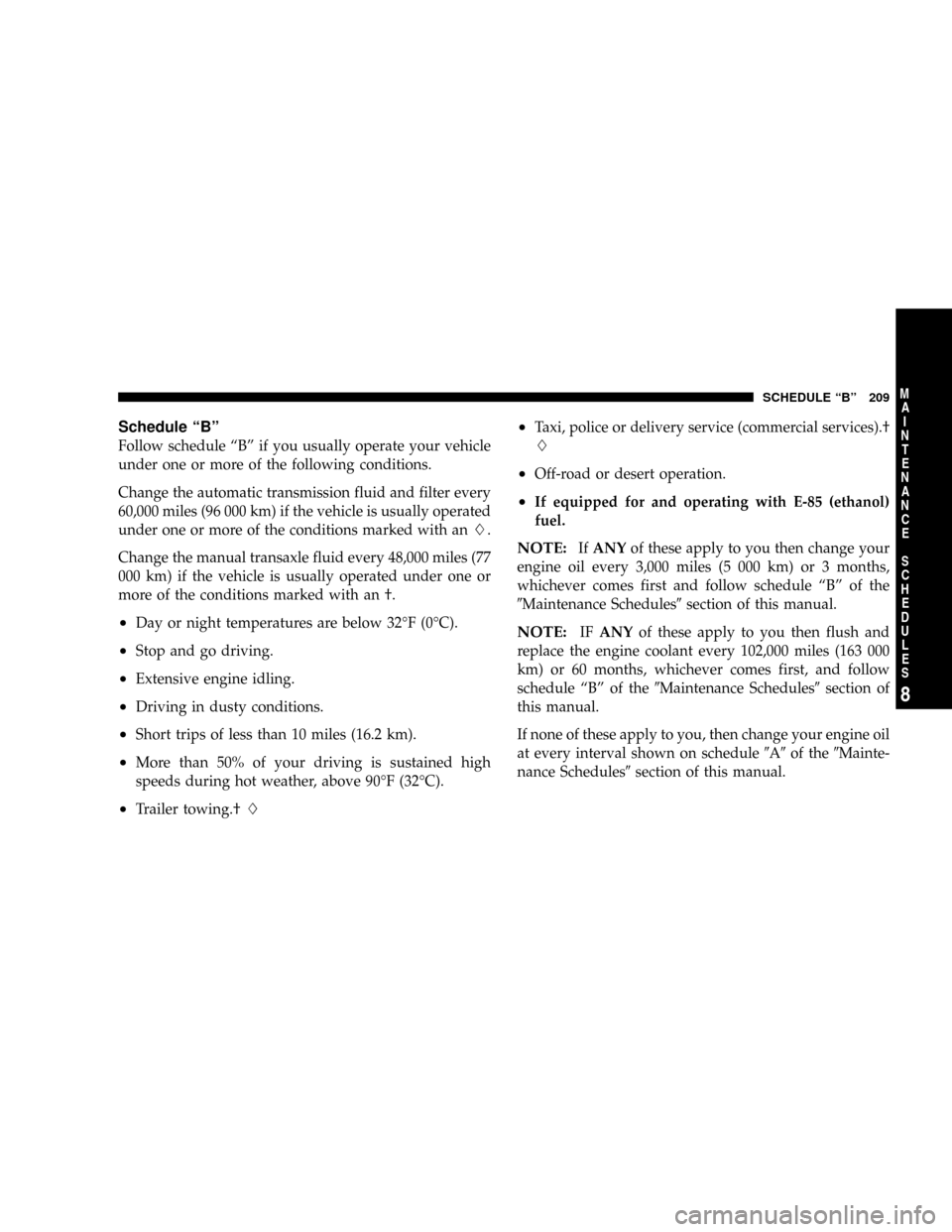2005 DODGE NEON fuel filter
[x] Cancel search: fuel filterPage 163 of 246

MAINTAINING YOUR VEHICLE
CONTENTS
m2.0L Engine Compartment...............165
mOnboard Diagnostic System Ð OBD II......166
mEmissions Inspection And Maintenance
Programs
............................167
mReplacement Parts.....................168
mDealer Service........................168
mMaintenance Procedures.................169
NEngine Oil..........................169
NIgnition Wiring System.................175
NCrankcase Emission Control System........175
NFuel Filter..........................175
NAir Cleaner Element (Filter)..............175NMaintenance-Free Battery................176
NAir Conditioner......................177
NPower Steering Fluid Check..............178
NFront Suspension Ball Joints..............178
NBody Lubrication.....................178
NWindshield Wiper Blades................179
NWindshield Wiper Blade Replacement.......179
NWindshield Washer Aiming..............180
NWindshield Washer Reservoir.............180
NExhaust System......................180
NCooling System.......................181
7
Page 173 of 246

Engine Oil Filter
The engine oil filter should be replaced at every engine
oil change.
Engine Oil Filter Selection
All of this manufacturers engines have a full-flow type
disposable oil filter. Use a filter of this type for replace-
ment. The quality of replacement filters varies consider-
ably. Only high quality filters should be used to assure
most efficient service. Mopar Engine Oil Filters are high
quality oil filters and are recommended.
Drive Belts Ð Check Condition and Tension
At the mileage shown in the maintenance schedules,
check all drive belts for condition and proper tension.
Improper belt tension can cause belt slippage and failure.
Inspect the drive belts for evidence of cuts, cracks, or
glazing and replace them if there is any sign of damage
which could result in belt failure. If adjustment is re-
quired, adjust the belts according to the specifications
and procedures shown in the Service Manual.Special tools are required to properly measure tension
and to restore belt tension to factory specifications. Also,
check belt routing to make sure there is no interference
between the belts and other engine components.
Spark Plugs
Spark plugs must fire properly to assure engine perfor-
mance and emission control. New plugs should be in-
stalled at the specified mileage. The entire set should be
replaced if there is any malfunction due to a faulty spark
plug. Check the specifications section for the proper type
of spark plug for use in your vehicle.
Catalytic Converter
The catalytic converter requires the use of unleaded fuel
only. Leaded gasoline will destroy the effectiveness of the
catalyst as an emission control device.
Under normal operating conditions, the catalytic con-
verter will not require maintenance. However, it is im-
portant to keep the engine properly tuned to assure
proper catalyst operation and prevent possible catalyst
damage.
MAINTAINING YOUR VEHICLE 173
7
Page 175 of 246

Ignition Wiring System
The ignition cables should be kept clean and properly
connected. Terminals should be fully seated. Cracked,
damaged, or faulty cables should be replaced.
Crankcase Emission Control System
Proper operation of this system depends on freedom
from sticking or plugging due to deposits. As vehicle
mileage builds up, the PCV valve and passages may
accumulate deposits. If a valve is not working properly,
replace it with a new valve. DO NOT ATTEMPT TO
CLEAN THE OLD PCV VALVE!
Check ventilation hose for indication of damage or
plugging deposits. Replace if necessary.
Fuel Filter
A plugged fuel filter can cause hard starting or limit the
speed at which a vehicle can be driven. Should an
excessive amount of dirt accumulate in the fuel tank,
frequent filter replacement may be necessary.
Air Cleaner Element (Filter)
Under normal driving conditions, replace the filter at the
intervals shown on Schedule ªAº. If, however, you drive
the vehicle frequently under dusty or severe conditions,
the filter element should be inspected periodically and
replaced if necessary at the intervals shown on Schedule
ªBº.
WARNING!
The air cleaner can provide a measure of protection
in the case of engine backfire. Do not remove the air
cleaner unless such removal is necessary for repair or
maintenance. Make sure that no one is near the
engine compartment before starting the vehicle with
the air cleaner removed. Failure to do so can result in
serious personal injury.
MAINTAINING YOUR VEHICLE 175
7
Page 202 of 246

FLUIDS AND CAPACITIES
U.S. Metric
Fuel (Approximate)
2.0L Engines 87 Octane 12.5 Gallons 47.5 Liters
Engine Oil-With Filter
2.0 Liter Engines (SAE 5W-20, API Certified Engine Oil) 4.5 qts 4.3 Liters
Cooling System *
2.0 Liter Engines (MopartAntifreeze/Coolant 5 Year/100,000
Mile Formula), or equivalent.6.5 qts 6.2 Liters
* Includes heater and coolant recovery bottle filled to MAX level.
202 MAINTAINING YOUR VEHICLE
Page 203 of 246

RECOMMENDED FLUIDS, LUBRICANTS AND
GENUINE PARTS
Engine
Component Fluids, Lubricants and Genuine Parts
Engine Coolant MopartAntifreeze/Coolant 5 Year/100,000 Mile Formula HOAT (Hybrid Or-
ganic Additive Technology) or equivalent
Engine Oil Use API Certified SAE 5W-20 Engine Oil. Refer to your engine oil filler cap
for correct SAE grade meeting DaimlerChrysler Material Standard MS-6395.
Engine Oil Filter Mopar 4105409 or equivalent.
Spark Plugs Refer to the Vehicle Emission Control Information label in the engine com-
partment.
Fuel Selection 87 Octane.
Chassis
Component Fluids, Lubricants and Genuine Parts.
Automatic Transmission MopartATF+4 Automatic Transmission Fluid or equivalent.
Manual Transmission Fluid MopartATF+4 Automatic Transmission Fluid or equivalent.
Brake Master Cylinder MopartDOT 3, SAE J1703 should be used. If DOT 3, SAE J1703 brake
fluid is not available, then DOT 4 is acceptable. Use only recommended
brake fluids or equivalent.
Power Steering Reservoir MopartATF+4 Automatic Transmission Fluid or equivalent
MAINTAINING YOUR VEHICLE 203
7
Page 209 of 246

Schedule ªBº
Follow schedule ªBº if you usually operate your vehicle
under one or more of the following conditions.
Change the automatic transmission fluid and filter every
60,000 miles (96 000 km) if the vehicle is usually operated
under one or more of the conditions marked with anL.
Change the manual transaxle fluid every 48,000 miles (77
000 km) if the vehicle is usually operated under one or
more of the conditions marked with an ².
²Day or night temperatures are below 32ÉF (0ÉC).
²Stop and go driving.
²Extensive engine idling.
²Driving in dusty conditions.
²Short trips of less than 10 miles (16.2 km).
²More than 50% of your driving is sustained high
speeds during hot weather, above 90ÉF (32ÉC).
²Trailer towing.²L
²Taxi, police or delivery service (commercial services).²
L
²Off-road or desert operation.
²If equipped for and operating with E-85 (ethanol)
fuel.
NOTE:IfANYof these apply to you then change your
engine oil every 3,000 miles (5 000 km) or 3 months,
whichever comes first and follow schedule ªBº of the
9Maintenance Schedules9section of this manual.
NOTE:IFANYof these apply to you then flush and
replace the engine coolant every 102,000 miles (163 000
km) or 60 months, whichever comes first, and follow
schedule ªBº of the9Maintenance Schedules9section of
this manual.
If none of these apply to you, then change your engine oil
at every interval shown on schedule9A9of the9Mainte-
nance Schedules9section of this manual.
SCHEDULE ªBº 209
8
M
A
I
N
T
E
N
A
N
C
E
S
C
H
E
D
U
L
E
S
Page 234 of 246

ABS (Anti-Lock Brake) System............. 123
Adding Engine Coolant (Antifreeze)......... 183
Adding Fuel.......................... 144
Air Cleaner, Engine (Engine Air Cleaner Filter) . 175
Air Conditioning....................103,177
Air Conditioning Controls................ 103
Air Conditioning Refrigerant.............. 177
Air Conditioning System................. 177
Air Pressure, Tires...................... 133
Airbag................................ 31
Airbag Deployment...................... 36
Airbag Light.......................39,47,79
Airbag Maintenance...................... 38
Airbag, Side........................... 37
Alarm, Panic........................... 20
Alarm System........................22,79
Alignment and Balance.................. 139
Alterations/Modifications, Vehicle............ 6
Antenna, Satellite Radio................... 96
Antifreeze (Engine Coolant).........182,202,203
Capacities........................... 202
Disposal............................ 184
Anti-Lock Brake System (ABS)............. 123Anti-Lock Warning Light.................. 77
Anti-Theft Security Alarm................. 22
Appearance Care....................... 191
Arming Theft System..................... 22
Ashtrays and Lighter..................... 70
Automatic Door Locks.................... 16
Automatic Transaxle........... 9,114,116,117,188
Fluid and Filter Changes................ 190
Fluid Level Check..................... 188
Interlock System....................14,116
Reset Mode.......................... 117
Selection Of Lubricant................. 188
Shifting............................. 117
Special Additives..................... 190
Ball Joints............................ 178
Battery............................... 176
Keyless Transmitter Replacement.......... 21
Belts, Drive........................... 173
Belts, Engine.......................... 174
Body Mechanism Lubrication.............. 178
B-Pillar Location....................... 128
Brake Fluid........................... 203
234 INDEX
Page 237 of 246

Emergency, In Case of
Jacking............................. 152
Jump Starting........................ 155
Towing............................. 160
Emergency Trunk Release................. 18
Emission Control System Maintenance....167,206
Engine............................... 165
Break-In Recommendations............... 46
Checking Oil Level.................... 169
Compartment........................ 165
Cooling............................ 181
Exhaust Gas Caution.................. 144
Jump Starting........................ 155
Oil ..........................169,202,203
Oil Change Interval................... 170
Oil Filler Cap........................ 172
Oil Filter............................ 203
Oil Selection......................... 171
Oil Synthetic......................... 172
Overheating......................... 150
Temperature Gauge.................... 81
Timing Belt.......................... 174
Exhaust Gas Caution..................46,144Exhaust Pipes......................... 180
Exhaust System........................ 180
Extender, Seat Belt....................... 31
Filters
Air Cleaner.......................... 175
Automatic Transaxle................... 190
Engine Fuel......................... 175
Engine Oil.......................173,203
Flashers
Hazard Warning...................... 150
Flooded Engine Starting.................. 115
Fluid, Brake........................... 203
Fluid Capacities........................ 202
Fluid Leaks............................ 47
Fluid Level Checks
Automatic Transaxle................... 188
Manual Transaxle..................... 190
Fluids............................... 203
Fog Lights...........................62,77
Folding Rear Seat....................... 57
Freeing A Stuck Vehicle.................. 159
Front Suspension Ball Joints............... 178
INDEX 237
10